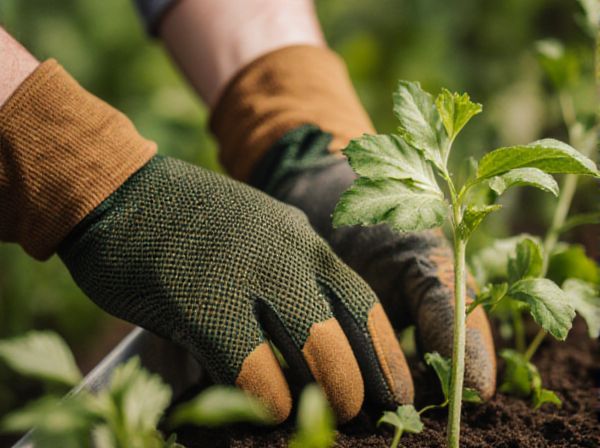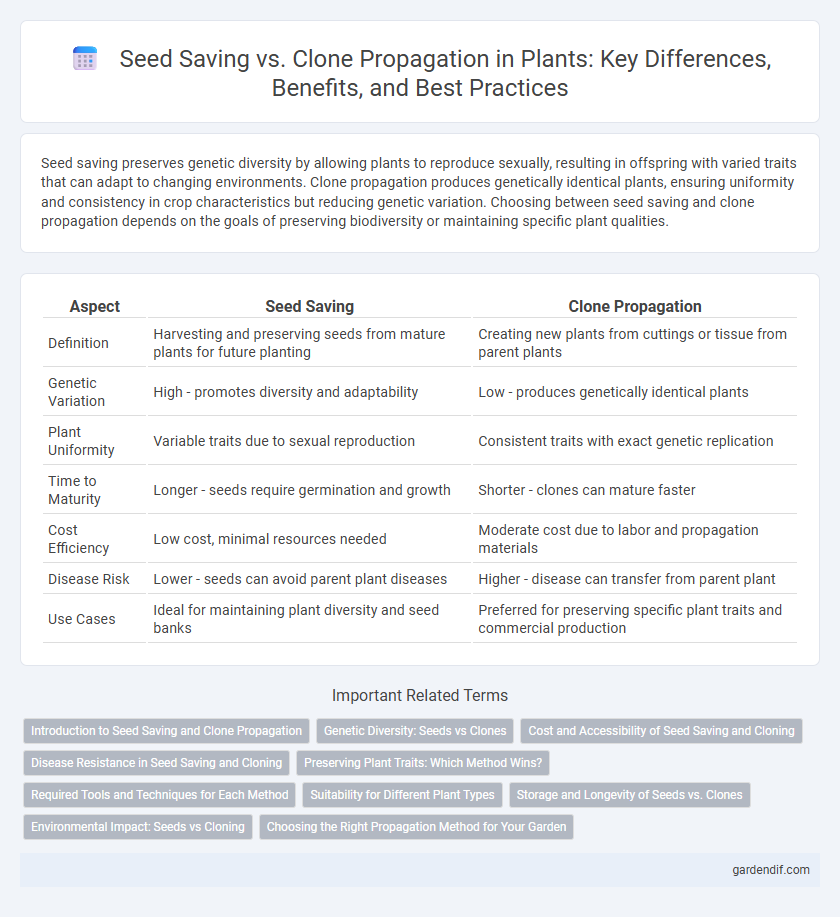
Seed Saving vs Clone Propagation Illustration
Seed saving preserves genetic diversity by allowing plants to reproduce sexually, resulting in offspring with varied traits that can adapt to changing environments. Clone propagation produces genetically identical plants, ensuring uniformity and consistency in crop characteristics but reducing genetic variation. Choosing between seed saving and clone propagation depends on the goals of preserving biodiversity or maintaining specific plant qualities.
Table of Comparison
| Aspect | Seed Saving | Clone Propagation |
|---|---|---|
| Definition | Harvesting and preserving seeds from mature plants for future planting | Creating new plants from cuttings or tissue from parent plants |
| Genetic Variation | High - promotes diversity and adaptability | Low - produces genetically identical plants |
| Plant Uniformity | Variable traits due to sexual reproduction | Consistent traits with exact genetic replication |
| Time to Maturity | Longer - seeds require germination and growth | Shorter - clones can mature faster |
| Cost Efficiency | Low cost, minimal resources needed | Moderate cost due to labor and propagation materials |
| Disease Risk | Lower - seeds can avoid parent plant diseases | Higher - disease can transfer from parent plant |
| Use Cases | Ideal for maintaining plant diversity and seed banks | Preferred for preserving specific plant traits and commercial production |
Introduction to Seed Saving and Clone Propagation
Seed saving involves collecting and preserving seeds from mature plants to grow new plants with genetic diversity, which can enhance resilience and adaptability. Clone propagation, or vegetative propagation, creates genetically identical plants through methods like cuttings, grafting, or tissue culture, ensuring uniformity in traits. Both techniques are essential in sustainable agriculture for maintaining plant varieties and optimizing crop production.
Genetic Diversity: Seeds vs Clones
Seed saving promotes genetic diversity by allowing natural recombination and variation within plant populations, resulting in offspring with diverse traits and improved adaptability to environmental changes. Clone propagation produces genetically identical plants, ensuring uniformity but reducing genetic variation and increasing vulnerability to pests and diseases. Maintaining genetic diversity through seed saving is crucial for the resilience and long-term sustainability of crops.
Cost and Accessibility of Seed Saving and Cloning
Seed saving offers a cost-effective method for plant reproduction, requiring minimal initial investment and accessible tools such as drying racks and storage containers, making it ideal for gardeners and farmers with limited resources. Clone propagation, while more expensive due to the need for specialized equipment like rooting hormones, growth mediums, and sometimes controlled environments, provides faster and predictable plant replication. Accessibility favors seed saving for beginners and small-scale growers, whereas cloning is often favored in commercial operations prioritizing uniformity and high success rates.
Disease Resistance in Seed Saving and Cloning
Seed saving enhances disease resistance by promoting genetic diversity within plant populations, enabling offspring to adapt to evolving pathogens and environmental stresses. Clone propagation maintains uniformity but increases vulnerability to diseases, as genetically identical plants share the same susceptibility traits. Employing seed saving techniques supports robust, resilient crops, while cloning offers consistency at the cost of reduced disease adaptability.
Preserving Plant Traits: Which Method Wins?
Seed saving preserves genetic diversity by capturing the unique combination of traits from parent plants, allowing adaptation to changing environments and resistance to pests. Clone propagation ensures exact replication of desirable plant traits, maintaining consistency in fruit size, flavor, or flower color across generations. The choice depends on whether preserving genetic variation or maintaining uniformity in plant characteristics is the priority for growers.
Required Tools and Techniques for Each Method
Seed saving requires tools such as seed trays, drying screens, and airtight containers, alongside techniques like selecting mature seeds, cleaning, and proper storage to maintain viability. Clone propagation involves using pruning shears, rooting hormones, and propagation trays or pots with a controlled environment to enhance root development and ensure genetic consistency. Each method demands specific skills: seed saving emphasizes genetic diversity preservation, while cloning focuses on replicating desirable traits efficiently.
Suitability for Different Plant Types
Seed saving is ideal for plants that reproduce sexually, such as tomatoes and beans, offering genetic diversity and adaptability to changing environments. Clone propagation suits plants like roses and succulents that reproduce asexually, ensuring genetic consistency and preserving desired traits. Selection between these methods depends on whether maintaining genetic variation or uniformity is more critical for the plant species.
Storage and Longevity of Seeds vs. Clones
Seed saving offers longer storage potential, with properly dried and stored seeds remaining viable for several years due to their natural dormancy mechanisms. Clone propagation requires maintaining living plant tissues, which limits storage duration to a few weeks or months under ideal conditions such as refrigeration or tissue culture. Seeds provide genetic diversity and durability, whereas clones ensure genetic uniformity but demand continuous care to preserve viability.
Environmental Impact: Seeds vs Cloning
Seed saving promotes genetic diversity, enhancing plant resilience and adaptability to changing environmental conditions, while reducing reliance on synthetic inputs and preserving biodiversity. In contrast, clone propagation often leads to uniform crops, which may increase vulnerability to pests and diseases, potentially necessitating higher chemical use. Choosing seed saving supports sustainable agriculture by maintaining ecosystem balance and reducing environmental footprint compared to cloning methods.
Choosing the Right Propagation Method for Your Garden
Selecting the appropriate propagation method depends on your plant species, garden goals, and desired genetic traits. Seed saving preserves genetic diversity and adapts plants to local conditions, while clone propagation ensures uniformity and rapid reproduction of specific cultivars. Understanding factors like growth rate, disease resistance, and plant stability helps optimize crop yield and maintain garden health.
Seed Saving vs Clone Propagation Infographic

 gardendif.com
gardendif.com